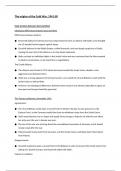The origins of the Cold War, 1941-58
Early tensions between East and West
Ideological differences between East and West
Differences between leaders:
● Roosevelt believed in democracy but compromised to form an alliance with Stalin as he thought
the US needed Soviet support against Japan.
● Churchill believed in the British Empire, unlike Roosevelt, and was deeply suspicious of Stalin,
viewing his own role in the alliance as to stop Soviet expansion.
● Stalin cut back on individual rights in the Soviet Union and was convinced that the West wanted
to destroy communism, so he stood firm in negotiations.
The Grand Alliance:
● The alliance was formed in 1941 when Germany invaded the Soviet Union, despite a non-
aggression pact between them.
● Stalin was a strong opponent of German fascism, so it suited the US and Britain to work with the
Soviet Union to defeat Hitler.
● However, the ideological differences between them meant it was almost impossible to agree on
how post-war Europe should be governed.
The Tehran conference, November 1943
Agreements:
● The US and Britain would open a second front in Western Europe to ease pressure on the
Eastern Front, as the Germans would then have to withdraw troops from the Soviet Union.
● Stalin would declare war on Japan and supply Soviet troops to help the US with the war effort,
but only once the war in Europe was over.
● The aim of the war was to bring about the unconditional surrender of Germany, and it should
remain weak after the war.
● Poland would receive land from Germany, and the Soviet Union could keep land it had seized
from Poland.
Disagreements:
● Churchill wanted to open a second front in the Balkans in order to prevent the Soviet Union from
taking over Eastern Europe, but Roosevelt sided with Stalin.
Impact on relations:
,● Stalin was concerned that the US and Britain were deliberately delaying opening a second front
against Germany so that the Soviet Union would be further weakened, so he was pleased with
the agreement.
The Yalta conference, February 1945
Agreements:
● Germany would be split into four zones, controlled by different countries, and would pay $20
billion in reparations, half of which would go to the Soviet Union.
● Stalin agreed to join the war against Japan, three months after the defeat of Germany, and that
free elections would be held in Eastern Europe.
● The Polish borders would return to their 1921 position, giving the Soviet Union significant gains,
and there would be free elections.
● The UN would hold its first meeting in April 1945 for all nations.
Disagreements:
● Stalin wanted more reparations to be paid to the Soviet Union by Germany.
● Stalin wanted a communist government to be elected in Poland, but Britain supported the non-
communist London Poles.
● The US did not agree to Stalin's suggestion that all of the Soviet republics should be given
individual membership to the UN.
Impact on relations:
● Roosevelt and Stalin were pleased to get an agreement on free elections and the UN.
The Potsdam conference, July 1945
Agreements:
● Germany would be divided into four zones, but the German economy would be run as a whole.
● Berlin would also be divided into four zones, controlled by different countries.
● Each administering country would take reparations from its own zone, but as the Soviet Union
controlled the poorest zone, it could take industrial equipment from the other zones.
Disagreements:
● The Soviet Union wanted Germany to pay heavy reparations, but Truman was concerned that
this would make it harder for the German economy to recover.
, ● Truman objected to the control that the Soviet Union had over Eastern Europe and the
previously agreed arrangements for Poland.
Impact on relations:
● Truman wanted to take a tougher approach with Stalin, and the development of the atom bomb
increased tensions between the US and Soviet Union.
US-Soviet relations, 1945-46
The impact of the atom bomb:
● In 1945, the US exploded two atom bombs over Hiroshima and Nagasaki, killing over 120,000
Japanese civilians.
● Some historians argue that the US used the bombs to establish a stronger bargaining position
with the Soviet Union.
● Stalin now felt more determined to make the Soviet Union secure, and his immediate aim was to
create a buffer zone of communist countries between Germany and the Soviet Union.
● The Soviet Union's first successful atom bomb test was in 1949, which dramatically increased
tensions.
The Long Telegram:
● In 1946, George Kennan, the American ambassador in Moscow, sent a telegram reporting that
Stalin wanted to see the destruction of capitalism and felt that the world outside was hostile.
● However, Kennan also believed that the Soviet Union was not suicidal, so would back down if
faced with strong resistance.
● This message led to the US policy of containment.
The Novikov Telegram:
● In 1946, Nikolai Novikov, a Soviet diplomat in Washington, sent a telegram stating that the US
wanted to use their massive military power to dominate the world.
● He believed that, since Roosevelt's death, the US no longer wanted to co-operate with the Soviet
Union and the American people would support their government if this led to war.
● This view had a major impact in Moscow, who wanted as much protection as possible in Eastern
Europe.
Churchill's 'Iron Curtain' speech:
● In 1946, Churchill gave a speech in Missouri where he made it clear that he thought the Soviet
Union was a threat to freedom and world peace.





